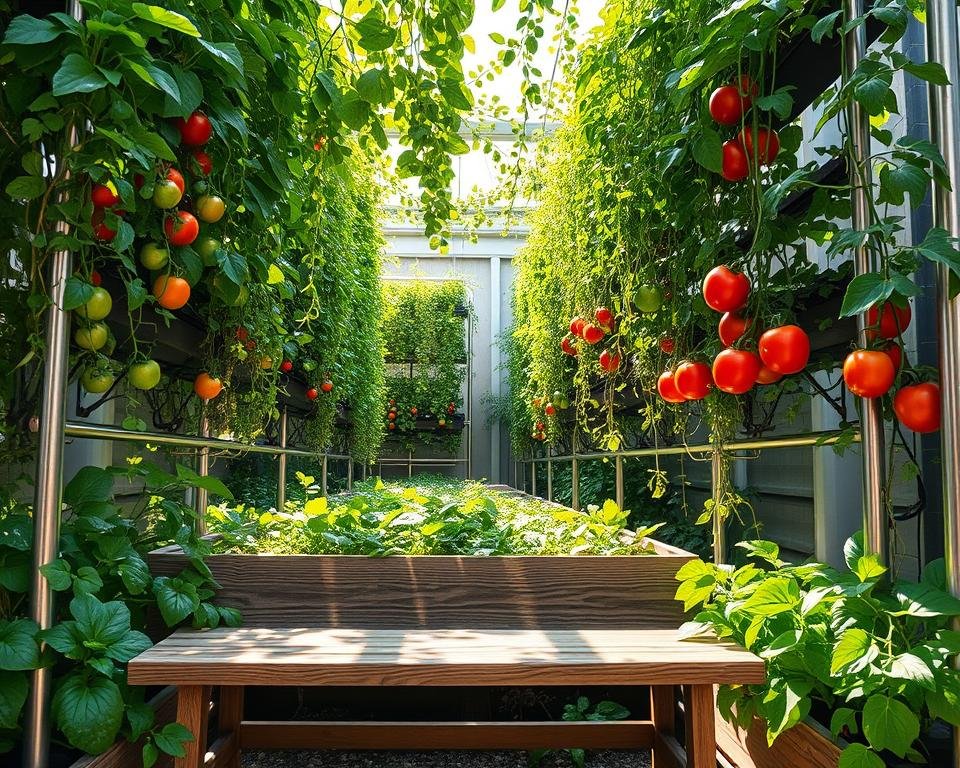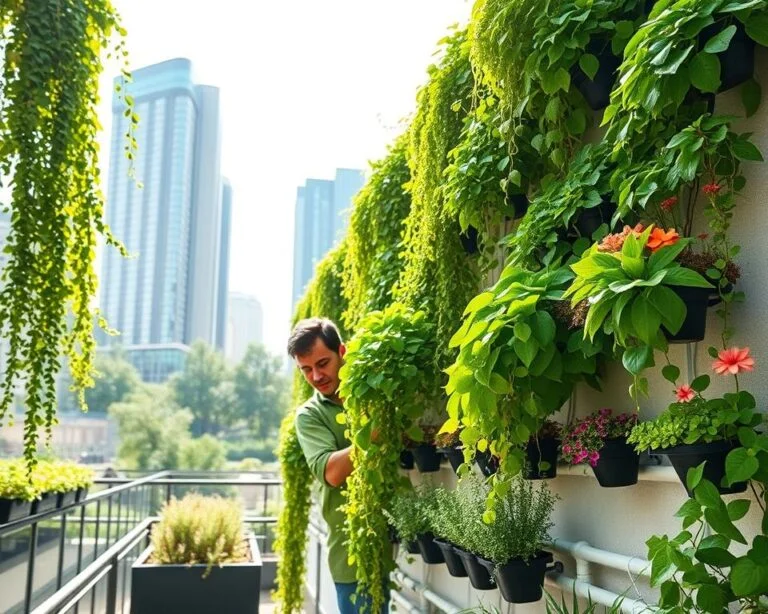Vegetable Gardens: Growing Vertically for Urban Yields
The concrete jungle of modern cities no longer limits your dream of growing fresh produce. Vertical gardening has emerged as a revolutionary solution for urban dwellers. It lets them reconnect with nature and cultivate their own sustainable vegetable gardens.
Imagine transforming a small balcony, rooftop, or compact backyard into a thriving urban farming ecosystem. With vertical gardening techniques, you can maximize limited space. You can produce an impressive array of fresh vegetables that rival traditional ground-based gardens.
Urban farming isn’t just a trend—it’s a practical response to shrinking agricultural land and growing food demands. By utilizing vertical growing methods, you can save up to 50% more space compared to conventional gardening. This makes every square foot count in your urban environment.
Key Takeaways
- Vertical gardens can produce high yields in minimal urban spaces
- Save up to 50% more space compared to traditional gardening
- Reduce water usage and environmental impact
- Accessible gardening method for urban residents
- Potential to grow diverse vegetables year-round
Understanding Vertical Farming Fundamentals
Vertical farming is a new way to grow plants in cities. It uses space in a smart way by stacking plants on top of each other. This method is great for growing vegetables in small areas.
Vertical farming changes farming for the better. It’s efficient and good for the planet. Here are some big benefits:
- Produces up to 10 times higher yields per square foot compared to traditional farming
- Uses 90% less water than conventional agricultural methods
- Enables year-round crop production
- Reduces transportation distances by 50% or more
Space-Saving Design Principles
Vertical farming uses smart designs to grow more plants. It turns small spaces into gardens. The key parts include:
- Vertical shelving units
- Hydroponic or aeroponic growing techniques
- LED lighting for optimal plant growth
- Precision climate control
Environmental Impact and Sustainability
Vertical farming is good for the planet. It uses less land and water. Studies show it can cut down on pollution and waste.
“Vertical farming is not just a trend, but a practical solution for sustainable urban agriculture.”
Vertical farming could change how we grow food. It’s a step towards better, greener farming.
Essential Equipment and Setup Requirements
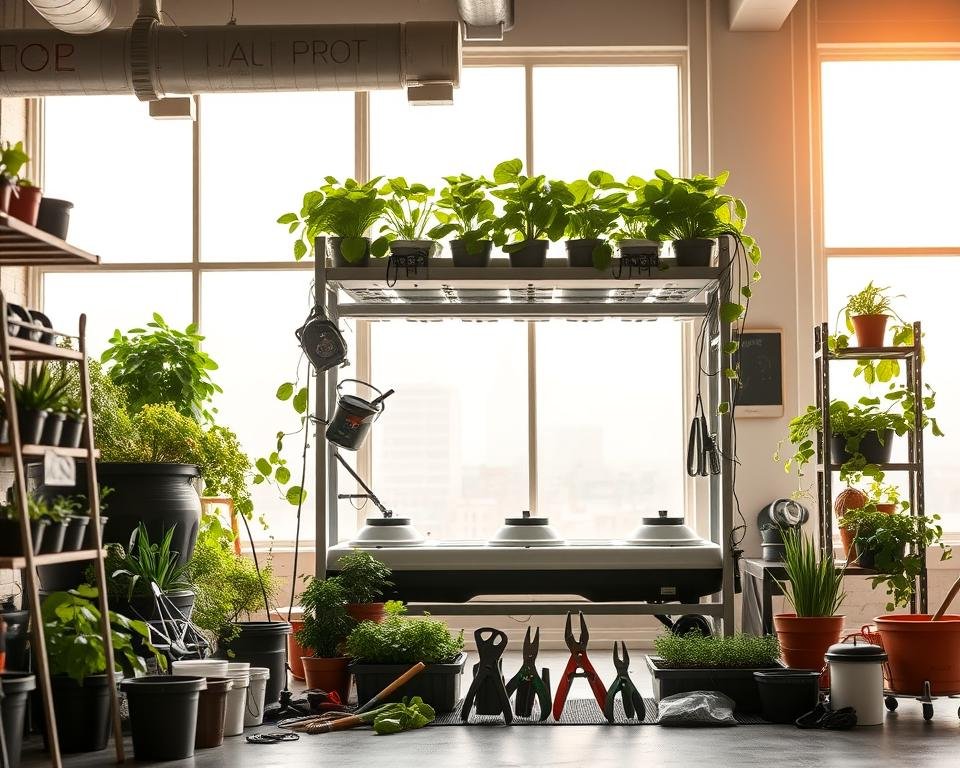
To create a successful vertical garden, you need the right tools and a good plan. Your journey in urban gardening begins with knowing the key equipment for success.
“The right tools can transform a small space into a productive garden ecosystem.” – Urban Gardening Expert
When setting up your vertical garden, certain tools are crucial. They make gardening easier and more fun. Let’s look at the important equipment for your urban gardening adventure.
Essential Gardening Tools
- Long-handled tools with ergonomic designs for reduced back strain
- Quality garden fork for turning garden soil
- Bypass-style hand pruners for precise plant maintenance
- Padded kneelers for comfort during gardening tasks
Raised Beds and Container Selection
| Raised Bed Feature | Benefit |
|---|---|
| 3-4 foot width | Maximizes growing area, minimizes path space |
| Vertical structure | Increases plant density in small spaces |
| Soil depth | Supports root development for various crops |
Your choice of raised beds greatly affects garden productivity. A well-designed raised bed can make your garden more efficient. It uses less space but offers more growing room.
Irrigation and Monitoring
- Soaker hoses for water-efficient irrigation
- Small soil monitor for tracking water, sunlight, and pH levels
- Watering can with minimum 2-gallon capacity
Urban gardeners should use smart irrigation methods. A good soil monitor helps you understand your garden’s needs. This ensures your plants stay healthy in small spaces.
Pro Tip: Implement crop rotation and interplanting strategies to maximize your vertical garden’s productivity and maintain soil health.
Best Vegetables for Vertical Gardens
Vertical gardening turns small spaces into productive gardens. By picking the right vegetables, you can get the most out of your space. Vertical growing techniques help urban gardeners grow fresh produce.
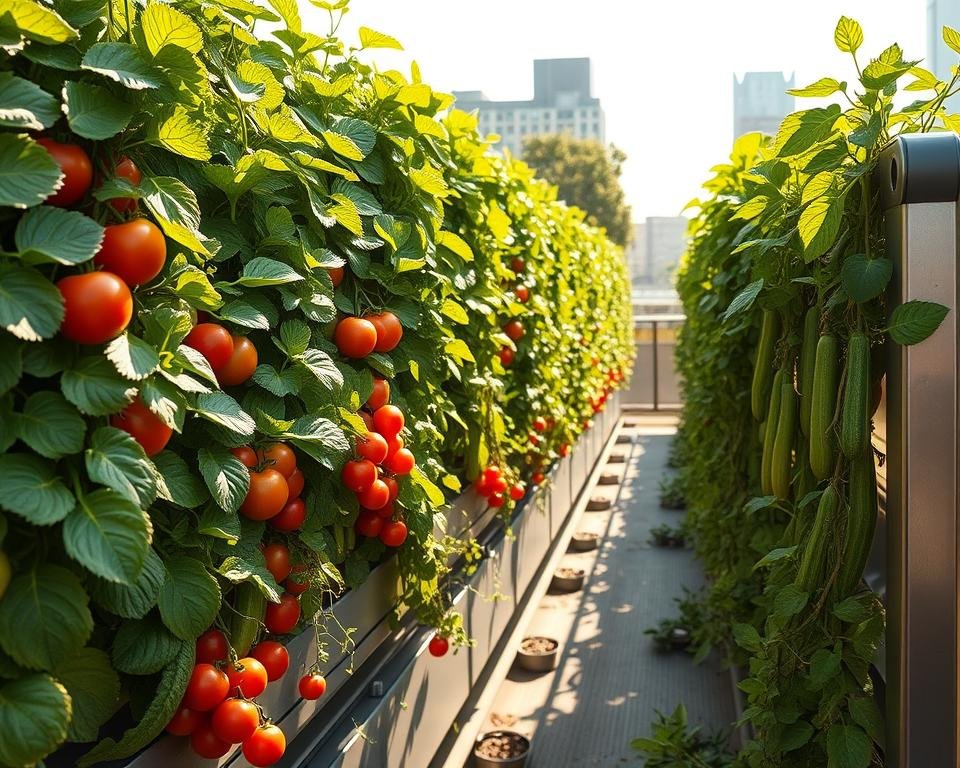
Knowing about crop rotation and companion planting is key for vertical gardens. These methods keep the soil healthy and help plants grow well in small spaces.
Climbing and Vining Plants
Vertical gardens do great with climbing vegetables that need support. Here are some top picks:
- Pole beans growing 6-10 feet tall
- Indeterminate tomatoes reaching up to 8 feet
- Vining cucumbers that thrive when spaced 6-8 inches apart
- Winter squash with expansive 9-12 foot vines
Leafy Greens and Herbs
Compact green varieties make vertical spaces lush and productive. Malabar spinach is great for hot weather. Many herbs also offer fresh flavors with little space.
Compact Fruiting Vegetables
Small vegetable varieties are ideal for vertical gardens. Choose:
- Smaller pumpkin types like Jack Be Little
- Compact tomato cultivars
- Dwarf pepper varieties
Vertical gardening isn’t just about saving space—it’s about creating an efficient, productive growing environment.
By using smart companion planting and crop rotation, you’ll have a strong and fruitful vertical garden. It will make the most of every inch of growing space.
Vegetable Gardens: Planning and Management
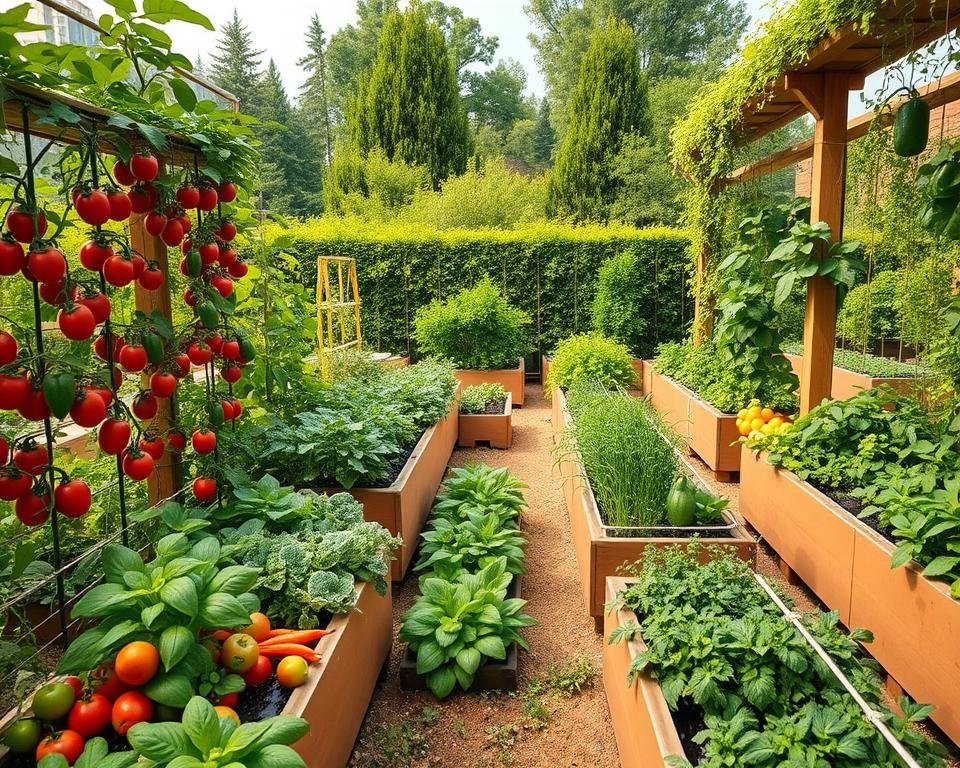
Creating a successful vertical vegetable garden needs careful planning and management. The garden’s success depends on many factors. These factors help plants grow well and produce a good harvest.
Understanding your garden’s environment is key. Most vegetables need 6-10 hours of direct sunlight daily. When setting up your garden, choose spots that get lots of sun and protect plants from strong winds.
“A well-planned garden is the foundation of bountiful harvests” – Urban Gardening Experts
Essential Planning Considerations
- Assess available sunlight and microclimates
- Select appropriate containers and support structures
- Choose compatible plant combinations
- Implement effective pest control strategies
Pest control is very important in vertical gardens. Using natural methods like companion planting and introducing beneficial insects helps. Regularly check your plants and remove any affected areas quickly to stop damage.
Harvesting Techniques
- Use clean, sharp pruning tools
- Harvest vegetables at peak ripeness
- Pick frequently to encourage continued production
- Store harvested produce properly
Succession planting helps your garden produce more. By planting every few weeks, you get a steady harvest all season. In zone 6a, for example, you can plant greens like mesclun mixes every two weeks from April to September.
With good planning and regular care, your vertical garden can do great. Studies show a small 10 by 15 foot garden can produce up to 210 pounds of food. That’s about 1.4 pounds per square foot.
Advanced Growing Techniques
To take your organic gardening to the next level, you need new ideas. Urban gardeners are finding ways to make small spaces work hard. They turn these areas into places where plants can thrive.
Hydroponic Systems Integration
Hydroponic systems are a game-changer for growing veggies without soil. They use water to feed plants, making your garden more efficient. New gardening tricks include growing plants in water. This method delivers nutrients directly to the roots, helping plants grow faster.
- Water-based nutrient solutions
- Precise mineral delivery
- Reduced water consumption
- Faster plant growth cycles
Controlled Environment Agriculture
For gardeners, the right conditions are key to growing great veggies. Controlled Environment Agriculture (CEA) lets you control temperature, humidity, and light. This way, you can make sure plants get what they need.
| Environment Factor | Optimal Range | Impact on Plants |
|---|---|---|
| Temperature | 65-75°F | Maximizes Growth Rate |
| Humidity | 50-70% | Prevents Plant Stress |
| Light Exposure | 12-16 hours | Enhances Photosynthesis |
Nutrient Management Strategies
Getting nutrients right is essential for organic gardening. Knowing what your plants need helps you feed them well. This leads to strong growth and lots of veggies.
“Nutrition is to plants what education is to humans – a fundamental pathway to growth and potential.” – Urban Gardening Expert
Keep an eye on how much your plants eat. Adjust the soil’s pH often. Try out different organic fertilizers to see what works best for your garden.
Conclusion
Vertical gardening is a game-changer for growing food in cities. It lets you grow more in less space. This guide shows how small areas can become green spaces for veggies, helping us live more sustainably.
Starting a vertical garden is more than just growing food. It’s about making the most of small spaces and solving big farming problems. With good planning and the right soil and plants, your city spot can turn into a garden. This garden will give you fresh food and even make your property more valuable.
As vertical farming gets better, you can lead the way in green farming. Begin small, keep learning, and watch your garden grow. The skills you gain will give you healthy food and help make cities more green and self-sufficient.
Urban gardeners show that you can grow a lot in little space. By using these tips, you can get big harvests, save money on food, and feel closer to where your food comes from. Your vertical garden is a step towards a greener, stronger future.

